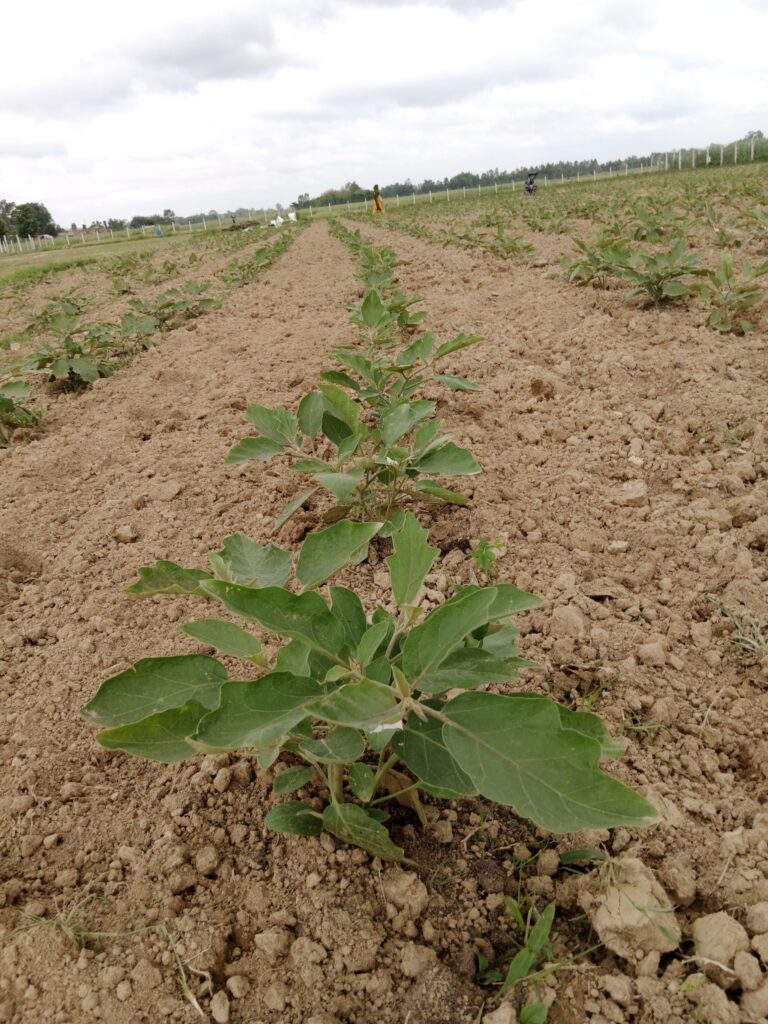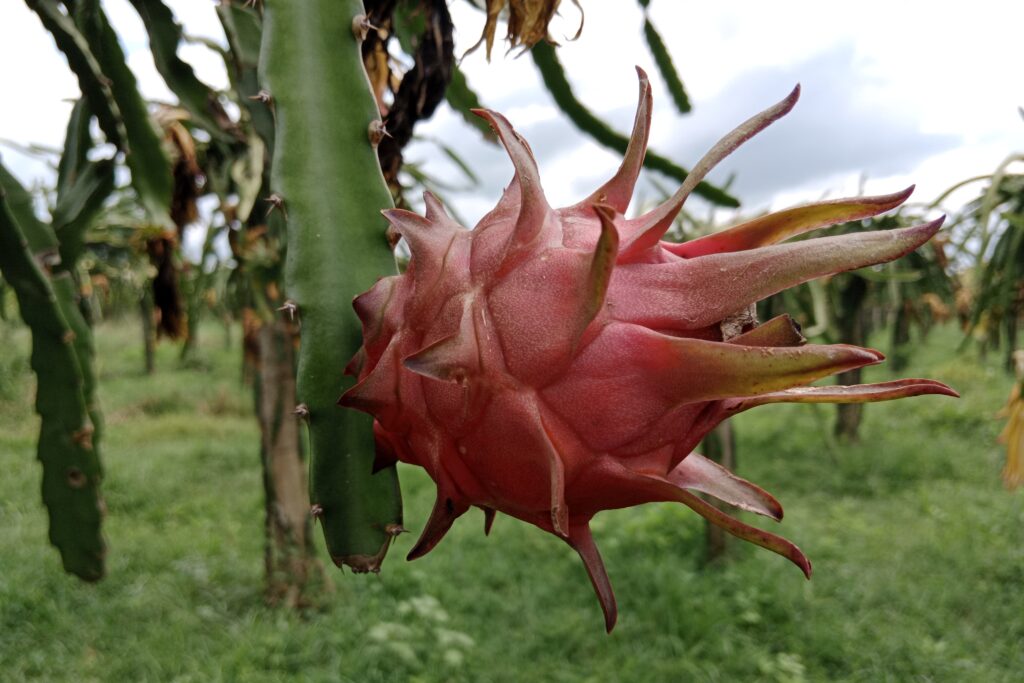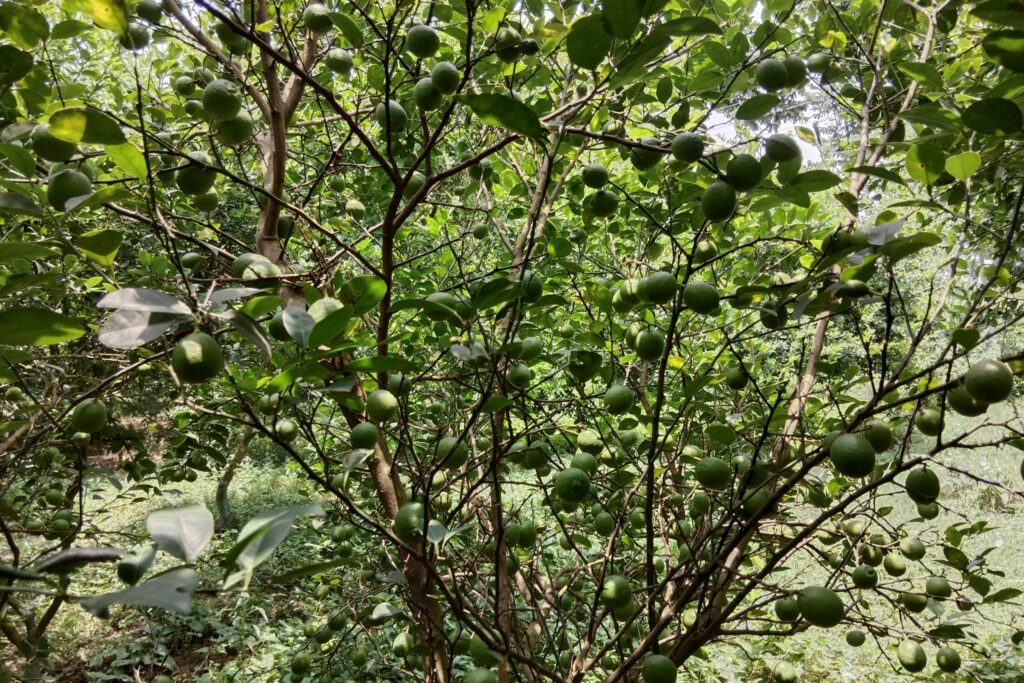Brinjal (Eggplant) Farming
Brinjal (Eggplant) Farming Profit Per Acre demonstrates exceptional economic viability, as evidenced by a gross profit of NRs 144,000 – calculated from total sales revenue minus all cultivation expenses. This substantial net earning underscores the significant income potential achievable through efficient farm management. The profitability is further highlighted by an extraordinary 313% profit margin, translating to NRs 313 gained for every NRs 100 invested.

Such metrics confirm brinjal cultivation as a highly lucrative agricultural enterprise, particularly when implementing yield optimization techniques (like hybrid varieties and protected cultivation) and cost-efficiency strategies (precision irrigation, integrated pest management). These returns reflect optimal conditions: 19,000 kg/acre yield at NRs 10/kg with total costs of NRs 46,000, positioning brinjal among Nepal’s most profitable cash crops.
Land Preparation
The goal is to prepare a fine, well-drained, and weed-free seedbed that supports optimal root development. This begins with deep ploughing (20–25 cm) using a mouldboard plough to break hardpans, improve soil aeration, and enhance drainage. Next, 2–3 cross harrowings are carried out to break large clods and level the field. During this process, weeds, stones, and remnants of previous crops must be removed to achieve a fine tilth—a crumbly soil texture.
Based on soil type and conditions, beds are then shaped: raised beds or ridges and furrows (15–20 cm high) are suitable for rainfed areas or heavy soils, while flatbeds are ideal for well-drained sandy loams. Finally, well-decomposed Farmyard Manure (FYM) or compost (15–20 tonnes per acre) is evenly incorporated as basal manure during the final harrowing or puddling stage.
Soil Type
A sandy loam or loam that is productive and well-drained is the best soil for growth. Although the soil can withstand a larger range from 5.0 to 7.0, the ideal pH range is slightly acidic to neutral (5.5–6.8). However, pH extremes within this tolerance limit can decrease nutrient availability. Saline or alkaline soils are also inappropriate, as are heavy clay soils because of their poor drainage and vulnerability to waterlogging, as well as highly sandy soils because of their poor capacity to retain water and nutrients.
Climatic Requirements
The crop thrives in warm-season conditions and is highly sensitive to frost, with optimal daytime temperatures ranging from 25–32°C and nighttime temperatures between 21–27°C. Germination requires soil temperatures above 15°C, with an ideal range of 25–30°C. Growth is significantly hindered below 16°C, flowers drop at temperatures above 35°C, and frost is fatal. The crop requires moderate rainfall (600–1000 mm) well-distributed throughout the growing season but cannot tolerate waterlogging, making supplemental irrigation crucial during dry spells. Full sunlight, with at least 6–8 hours daily, is essential for optimal flowering and fruiting.
Major Cultivars
Cultivar selection should prioritize several key factors: local market preference for shapes, sizes, and colors (such as purple, green, white, or striped) that are in demand; disease resistance, particularly to Bacterial Wilt, Little Leaf, and Fruit Borer; yield potential, noting that hybrid cultivars generally offer higher yields and greater uniformity; and climate suitability, ensuring varieties are adapted to specific regional growing conditions.”
| Cultivar Type | Examples of Varieties | |
| Long Slender | Pusa Purple Long, Pusa Kranti, Arka Navneet, Arka Keshav, Pant Rituraj | |
| Oblong/Oval | Arka Shirish, Pusa Bhairav, Pusa Ankur, Pusa Hybrid 6 | |
| Round | Black Beauty, Pusa Purple Round, Arka Kusumakar | |
| Small Round (Cluster) | Manjri Gota, Arka Samrat | |
| Specialty | Green (e.g., Mattu Gulla), White (e.g., Casper), Striped (e.g., Listada de Gandia) |
Seed Rate
To prepare the necessary seedlings for sowing one acre of land, use a seed rate of 300–400 grams. Always start with certified, high-quality seeds and treat them before planting: treat with 3 grams of Thiram or 3 grams of carbendazim per kilogram of seeds, then treat with 4 grams of Trichoderma viride per kilogram of seeds, let the treated seeds dry in the shade, and then plant right away.
Nursery Management
Brinjal seeds are sown in nursery beds (3m x 1m x 15cm) enriched with well-rotted manure and treated with Captan solution two days prior to planting. Seeds are sown in 5 cm rows, covered with compost or dry leaves, lightly watered, and covered with paddy straw or polythene sheets until germination. After germination, coverings are removed, and seedlings are irrigated lightly. Healthy seedlings (12–15 cm tall with 3–4 leaves) are transplanted in the evening.
Planting

a). Planting Season
The optimal planting seasons for brinjal vary by region: in the plains, the main sowing periods are June-July (Kharif season) and October-November (Rabi season), though with adequate irrigation it can be cultivated year-round except during peak winter or summer months; in hill regions, planting is typically done in March-April.
b). Spacing
When utilizing ridges and furrows, raise the row-to-row spacing to 75 cm while maintaining the plant-to-plant spacing at 60 cm. For bed planting, keep the spacing between rows at 60 cm and between plants within a row at 45 cm.
c). Pit Preparation
Prepare pits measuring 30 cm in length, width, and depth (30x30x30 cm) at the recommended spacing, filling each with a mixture of topsoil, 5-10 kg of well-decomposed FYM or compost, 100g neem cake, 20g Trichoderma viride, and recommended basal fertilizers (for example: 20g SSP + 10g MOP), ensuring thorough blending before transplanting.
d). Planting Method
Seedlings should be raised in protected nurseries (using raised beds, polybags, or protrays) for 4-6 weeks until they develop 4-5 true leaves. To acclimate them, begin hardening the seedlings by gradually exposing them to outdoor conditions 7-10 days before transplanting. Finally, transplant healthy, vigorous seedlings during cloudy weather or late afternoon, setting them slightly deeper than their nursery depth, and water immediately after planting
e). Number of Plants per Acre
Based on the above spacing, approximately 10,000 to 14,000 brinjal plants are typically accommodated per acre.
Intercropping

Brinjal’s upright growth habit and extended growing season make it well-suited for intercropping. Suitable companion crops include short-duration vegetables like onion, garlic, radish, spinach, coriander, bush beans, and marigold (which acts as a trap crop and pest repellent). This practice offers significant benefits such as more efficient land and water utilization, additional income streams, and natural weed suppression. Key considerations include avoiding tall or densely canopied crops that shade the brinjal, preventing competition for nutrients and water during critical growth stages, and maintaining an appropriate spatial arrangement between species.
Irrigation
| Aspect | Details |
| Critical Stages | Transplanting, flowering, fruit set & development |
| Frequency | • Summer: Every 3-4 days • Winter: Every 7-8 days • Rainy Season: As needed (based on rainfall) |
| Recommended Method | Drip irrigation (for water efficiency, reduced foliar diseases, and fertigation compatibility) |
| Alternative Method | Furrow irrigation |
| Method to Avoid | Overhead sprinklers |
| Key Requirements | • Maintain consistent soil moisture • Prevent water stress (causes flower/fruit drop and bitter fruits) • Avoid waterlogging |
Fetilizer and Manure Schedule for Brinjal Cultivation per Acre
| Application Type | Component | Quantity/Requirement | Timing/Method |
| Basal Dose | FYM/Compost | 15-20 tonnes | Incorporated during pit filling or bed preparation |
| Nitrogen (N) | 10-13.3 kg (1/3 of total N) | Applied entire P & K as basal application. | |
| Phosphorus (P₂O₅) | 50-60 kg (e.g., 310-375 kg SSP) | ||
| Potassium (K₂O) | 25-30 kg (e.g., 40-50 kg MOP) | ||
| Top Dressing | Nitrogen (N) | 20-26.7 kg (2/3 of total N) | Split into 2-3 equal applications: • 1st: 30 DAT • 2nd: 60 DAT (flowering) • 3rd: 90 DAT (fruiting) |
| Micronutrients | Zinc | 0.5% foliar spray | Applied if deficiencies observed |
| Boron | 0.1-0.2% foliar spray | ||
| Magnesium | As needed | ||
| Biofertilizers | Azospirillum/PSB | As per recommendation | Applied to soil or seedlings |
| General Notes | – | Soil testing essential | Adjust applications based on soil analysis |
Key: DAT = Days After Transplanting; SSP = Single Super Phosphate; MOP = Muriate of Potash; PSB = Phosphate Solubilizing Bacteria
Weed Control
The critical period for weed management in brinjal occurs during the first 45-60 days after transplanting. Effective methods include: mechanical control through 2-3 shallow hoeings or weedings (initiated at 20-25 DAT and repeated at 15-20 day intervals), avoiding deep cultivation near roots to prevent root damage; mulching with organic materials like paddy straw or dried leaves, or black plastic mulch (applied post-transplanting for superior weed suppression, moisture conservation, and early yield); and judicious chemical control using pre-emergence herbicides such as Pendimethalin (1.0-1.5 kg a.i./acre) or Fluchloralin (0.75-1.0 kg a.i./acre) incorporated into the soil before transplanting, or directed sprays later – always adhering strictly to label instructions to ensure safe and effective application.
Pest and Disease Management of Brinjal
Common Pests
a). Shoot & Fruit Borer
The fruit and shoot borer, a highly destructive pinkish caterpillar pest, severely impacts brinjal cultivation. It initially tunnels into terminal shoots to feed on internal tissues before migrating to young fruits, where its boring activity creates large entry holes, making infested fruits unmarketable. Effective management requires weekly field scouting starting after transplanting, with immediate removal and destruction of infected fruit.

Control measures commence one-month post-transplanting using alternating applications of Triazophos (20ml per 10 liters of water) and Neem extract (50gm per liter), repeated at 10–15-day intervals. During flowering, apply Chlorantraniliprole 18.5% SC (Coragen) at 5ml mixed with Teepol (5ml) in 12 liters of water twice, spacing applications 20 days apart.
Initial infestations should be treated with 5% Neem extract solution (50gm/liter), while sustained outbreaks warrant spraying either Cypermethrin 25% EC (2.4ml/10L water) or Spinosad (1ml/L water) for heavy infestations. Critically, cease all applications of Triazophos and other chemical insecticides once fruit maturation begins and during harvest periods.
b). Aphids, Jassids, Whiteflies
Brinjal plants are susceptible to sap-sucking pests including mites, aphids, and mealy bugs, which cause leaf yellowing and drooping by extracting plant fluids. If aphid or whitefly infestations occur, apply a combination spray of Deltamethrin + Triazophos @ 10ml per 10 liters of water. Additionally, to control whitefly populations, use Acetamiprid @ 5gm per 15 liters of water.
c). Leaf eating caterpillar
Caterpillar infestations in brinjals typically occur during the crop’s early growth stages. Initial control should prioritize neem-derived biopesticides. If these prove insufficient and infestation severity crosses economic thresholds, apply targeted chemical interventions: either Emamectin benzoate @ 4g or Lambda-cyhalothrin @ 2ml per liter of water. This threshold-based approach minimizes unnecessary chemical usage while ensuring effective pest suppression
d). Mites
If mite infestation is observed in the field, apply a spray of either Abamectin @ 1-2 ml per liter of water or Fenazaquin @ 2 ml per liter of water to control the pests.
Common Diseases
a). Bacterial Wilt

Wilt disease in brinjal manifests as yellowing followed by complete leaf drop and eventual wilting/drying of entire plants, with diagnostic confirmation shown by a characteristic white milky ooze released when infected stems are cut and submerged in water. Effective management requires: using resistant varieties; implementing soil solarization; practicing crop rotation with non-solanaceous crops for over 3 years; and applying a soil drench solution containing Streptocycline (0.5g/l) mixed with copper oxychloride (3g/l).
b). Phomopsis Blight & Fruit Rot
Phomopsis Blight and Fruit Rot in brinjal causes dark brown spots on leaves and watery lesions on fruits that turn black. Preventive management includes treating seeds prior to sowing with Thiram @ 3gm per kg of seeds and selecting blight-resistant varieties. If infestation appears in the field, apply fungicide sprays of either Zineb @ 2gm per liter of water or Mancozeb @ 2.5gm per liter of water.
c). Damping Off
Damping Off, a serious soil-borne disease of brinjal favored by moist and poorly drained soils, causes water-soaking and shriveling of stems, often killing seedlings before emergence. If it occurs in nurseries, entire seedling batches can be devastated. Prevention requires seed treatment with Thiram @ 3gm per kg of seeds and soil solarization of nursery beds. If symptoms appear, immediately drain excess water and drench the nursery soil with Copper Oxychloride @ 3gm per liter of water.
d). Little Leaf
Little Leaf disease causes affected leaves to thin, transforms petals into green leaf-like structures, and prevents infected plants from bearing fruit. Primarily transmitted by leaf hoppers (with secondary spread via aphids), management requires: using resistant varieties; applying 10% Foret (20g per 3m × 1m nursery bed); incorporating Phorate between seed rows at sowing; immediately removing infected plants upon detection; spraying Dimethoate or Oxydemeton Methyl @1ml/L water; and controlling aphid vectors with Thiamethoxam 25% WG (5g/15L water).
e). Fusarium Wilt
Fusarium Wilt in brinjal causes yellowing and wilting of plants; effective control strategies include using resistant varieties, implementing crop rotation, and applying soil solarization to suppress the pathogen.
f). Viral Diseases
Symptoms of the disease include light and green patches on leaves, formation of small blisters, and restricted leaf size. Management involves selecting healthy disease-free seeds and uprooting/destroying infected plants away from the field. For chemical control, adopt aphid management strategies: spray Acephate 75 SP @1gm per liter of water, Methyl Demeton 25 EC @2ml per liter of water, or Dimethoate @2ml per liter of water.
Harvesting
Harvest timing varies by cultivar: early types mature in 80-90 days after transplanting (DAT), while mid/late varieties require 100-150 DAT. Pick fruits at the immature, tender stage when they reach marketable size, develop their characteristic color (deep purple, green, white, etc.), and exhibit glossy skin with firm flesh—avoid over-mature fruits which turn dull, seedy, tough, and bitter.
Using sharp knives or secateurs, cut fruits with 2-3 cm of stalk (calyx) attached to minimize damage. Harvest every 3-4 days during peak season to promote continuous flowering and fruiting. Yields range widely: open-field cultivation yields 20-35 tonnes/acre under good management, while protected cultivation can exceed 50 tonnes/acre, with hybrids typically outperforming open-pollinated varieties.
Cost of Investment Per Acre for Brinjal Farming
| S.N. | Category | Cost (NRs) |
| 1 | Land Preparation | 15,000 |
| 2 | Seed Rate | 1,000 |
| 3 | Labor (Transplanting) | 3,000 |
| 4 | Fertilizers & Manure | 8,000 |
| 5 | Irrigation | 5,000 |
| 6 | Weed Control | 2,000 |
| 7 | Pest & Disease Control | 5,000 |
| 8 | Harvesting | 2,000 |
| 9 | Miscellaneous Costs | 5,000 |
| Total Investment Cost | 46,000 |
Income from Brinjal Farming Per Acre
| Particulars | Yield (kg) | Price (NRs/kg) | Income (NRs) |
| Brinjal Yield | 19,000 | 10 | 190,000 |
| Total Income | 190,000 |
Analysis of Brinjal Farming Profit Per Acre
The gross profit of NRs 144,000 represents the net earnings from brinjal cultivation, calculated by subtracting total production costs from total sales revenue. This substantial figure highlights significant earning potential when costs are well-managed.
Further demonstrating exceptional profitability, the profit margin stands at 313% – meaning for every NRs 100 invested, NRs 313 in profit is generated. This exceptionally high return confirms brinjal farming as a lucrative agricultural enterprise, particularly when yield optimization and cost efficiency strategies are implemented.


